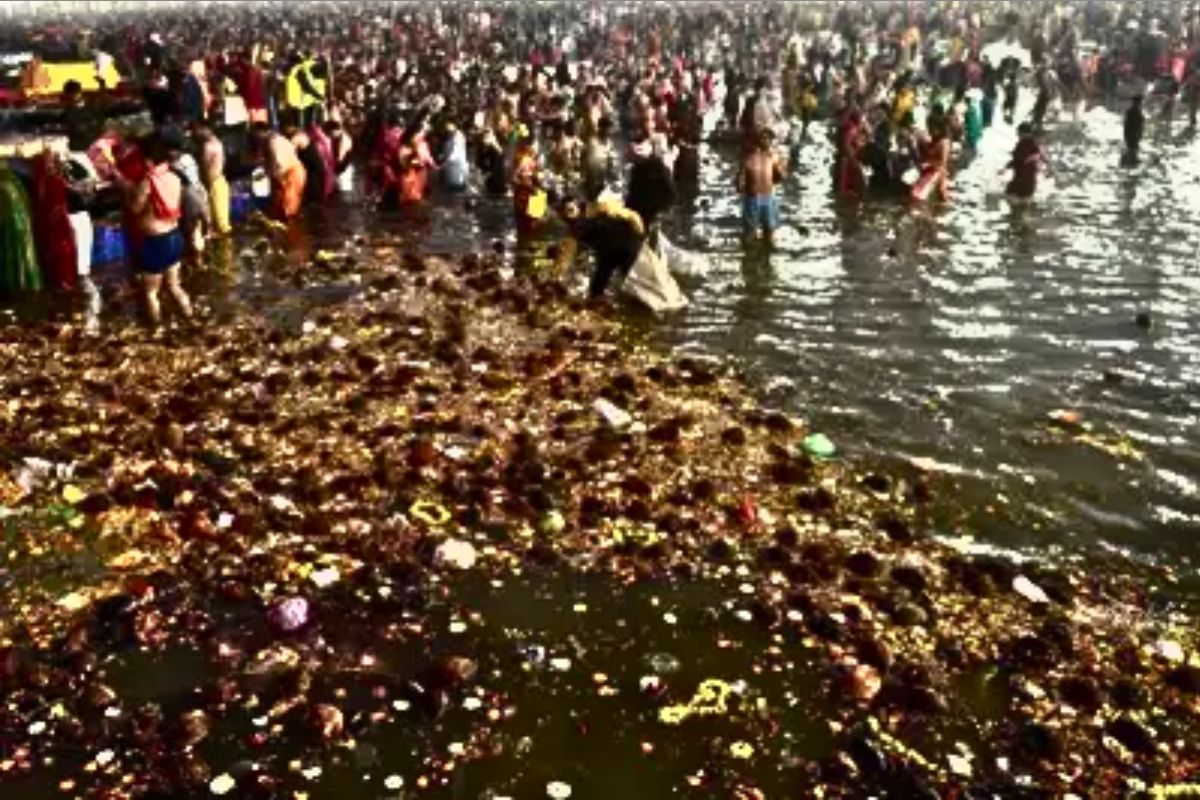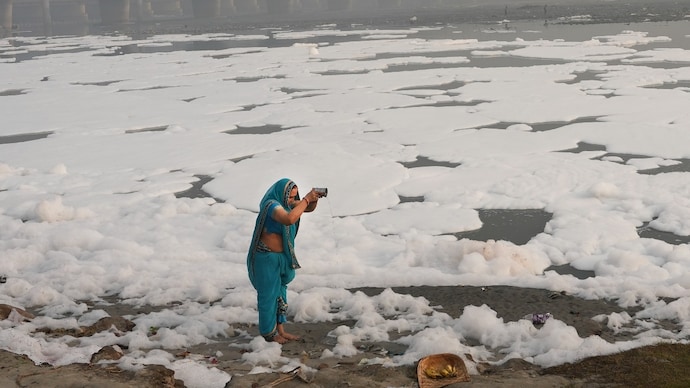CPCB Vs Yogi: Who Is True About Holy Sangam Water?

Do you know how you’re supposed to trust your leaders when they assure you that everything is fine? Especially when it comes to something as vital as clean water. Well, hold that thought because this isn’t that kind of story.
Once upon a time, in the land of eternal faith and spiritual cleansing, the waters of the Sangam in Prayagraj were believed to wash away sins, purify the soul, and basically hit the reset button on your karmic balance sheet. Today, they might also give you a crash course on the microbiological consequences of faith. According to recent reports, the Sacred Confluence isn’t exactly passing its health checkups. Tests conducted by the Central Pollution Control Board (CPCB) found shockingly high levels of faecal coliform in the water. That’s science-speak for saying it’s essentially a bacterial cocktail made possible by untreated sewage and industrial runoff.
But before you panic and cancel your next pilgrimage, here comes the twist. UP CM Yogi Adityanath has said these findings as mere “propaganda.” You heard it right. As per UP CM, those pesky scientists and their data, were just a conspiracy to malign the Maha Kumbh’s divine reputation. Apparently, the CPCB’s painstakingly gathered evidence is not a clarion call for urgent action but rather a nefarious plot cooked up by unnamed saboteurs. Who needs public health standards when you have faith, after all?

Faith Over Faecal Counts
For centuries, the waters of the Sangam have been a pilgrimage destination for millions. It’s where the Ganga, Yamuna, and the mythical Saraswati meet, forming what believers consider the holiest of bathing sites. During the Maha Kumbh Mela, an event that attracts devotees from all over the world, millions take a ceremonial dip, convinced that the holy waters will cleanse their sins and cure their ailments. And maybe they used to—before modern industrial civilization turned every major river into a glorified drainpipe.
Yet, even in the face of grim test results showing unsafe levels of faecal bacteria, UP’s chief minister insists that Sangam’s water is perfectly fine for bathing, even drinking. Why let a little thing like data ruin the show? If the CPCB’s findings are inconvenient, just brand them propaganda. Faith, it seems, can’t be quantified by scientific methods, and if you dare try, you’re probably just an agent of some anti-Indian agenda. Obviously, nothing screams international conspiracy like wanting to make sure millions don’t contract waterborne diseases.

Science vs. Sacred Narrative
The clash between science and faith is nothing new, but rarely is it so blatantly dismissed as “propaganda.” What makes this episode particularly disturbing is the sheer number of people it puts at risk. The CPCB’s findings indicate that the water at the Sangam not only fails to meet safe drinking standards but doesn’t even pass basic bathing criteria. In layman language, taking a dip may or may not just wash away sins, but it could also introduce a few stomach bugs, skin infections, or even worse!
Yet, here we are. Rather than taking immediate action to address pollution, build better sewage treatment facilities, and enforce stricter regulations on industrial discharge, the narrative has shifted to blame the messengers. The problem isn’t the contaminated water, you see. It’s those unpatriotic folks pointing out that the water is contaminated. How dare they suggest that a holy site might be suffering from very unholy pollution levels?
It’s Not Just About the Dip
Sceptics might argue, “Well, people have been bathing there for centuries, and they seem fine” which is as similar as ‘Why should I die because of smoking when my grandpa smoked all through his life and lived till 96’!!!
Sure, if you ignore rising cases of waterborne illnesses, increased antibiotic resistance due to exposure to contaminated water, and the countless individuals who might not even realize their health issues stem from a “holy” dip. The reality is that the world today is not what it was centuries ago. Rivers that once flowed clean and unspoiled have been turned into dumping grounds for human and industrial waste. Take the recent case of Yamuna.

The CPCB’s report isn’t an attack on religion or tradition; it’s a warning. It’s saying that what was once a sacred experience now comes with health risks that can no longer be ignored. To dismiss it as propaganda is not just irresponsible; it’s dangerous.
Propaganda vs. Prevention
By calling the report as propaganda, the focus shifts away from finding solutions. Public resources that could go toward cleanup efforts, improved sanitation, and stricter pollution controls are instead wasted on spinning narratives. Meanwhile, millions of devotees continue to believe the water is safe simply because a leader said so, putting their health at serious risk. Similar case was seen in the past when IVRI asserted that drinking cow urine is not good for human health, but on the other hand, certain people were talking in favour of drinking cow urine.
Let’s be real for a moment. When untreated sewage flows into rivers, when industrial waste is dumped without oversight, and when the very agencies tasked with maintaining water quality are ignored, the result is predictable: pollution. And no amount of faith can make faecal coliform levels magically disappear. That’s not propaganda. That’s basic microbiology.
The Real Conspiracy? Ignoring the Problem
If there’s any “propaganda” at play here, it’s the notion that faith alone can substitute for proper environmental policy. It’s the belief that public health concerns are somehow an affront to tradition. The real conspiracy is to convince millions that everything is fine when the evidence says otherwise. It’s in brushing off legitimate concerns as attacks on cultural heritage, rather than acknowledging that protecting that heritage requires keeping it safe and clean.
Ignoring pollution doesn’t preserve the sanctity of the Sangam. It diminishes it. True respect for a holy site means ensuring that it remains safe for everyone who comes to it. It means injecting funds in infrastructure to treat waste, making regulations on industries that pollute, and holding the people accountable who allow these critical conditions to rise.
Can Faith and Responsibility Can Coexist?
To be clear, this isn’t about questioning faith or the spiritual significance of the Sangam. It’s about recognizing that faith doesn’t have to be at odds with facts. The two can coexist if “Believers can cherish the spiritual importance of the Sangam while also demanding that its waters be clean and safe”. It’s not sacrilegious to want clean water; it’s common sense.
A truly responsible approach would be to acknowledge the problem, commit to fixing it, and ensure that the millions who flock to the Maha Kumbh can do so without endangering their health. That would be the real way to honour this sacred site—not by pretending the issue doesn’t exist, but by taking meaningful steps to preserve it for generations to come.
Final Thoughts: Beyond the Blame Game
So here we are. A sacred river confluence. A report that says it’s polluted. A leader who calls that report propaganda. And millions of people are caught in the middle. The stakes couldn’t be higher.
At last, the race is not between scoring political points or preserving public image. It’s about real people, aka WE, THE PEOPLE OF INDIA, real health risks, and real solutions. If we can’t even agree on the basic premise that polluted water is a problem, then how can we hope to fix it? Calling it propaganda won’t change the facts. And ignoring it won’t make it go away.
Faith may cleanse the soul, but clean water is what will protect the body. It’s time we stop pretending otherwise.




